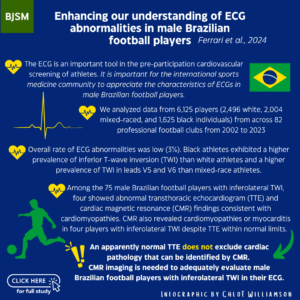Authors: Filipe Ferrari, Anderson D. da Silveira, Flávia C. O. Magalhães, Artur H. Herdy, Victor Froelicher, Ricardo Stein
In this blog, we will cover the process of developing an extensive 12-lead resting electrocardiogram (ECG) database of Brazilian football players, along with our key findings. Our study, recently published in BJSM, required four years of collaborative work among researchers from the five regions of Brazil.
Why is this study important?
The ECG is an important tool in the preparticipation cardiovascular screening of athletes, and it is essential to understand the distinctions between normal and abnormal patterns in male Brazilian football players. This understanding ensures safety during competitions and training, reducing the risks of cardiac complications and sudden death.
To date, ECG research has primarily focused on individuals of European or African descent, leaving significant data gaps on other ethnicities. In this context, mixed-race ethnicity was not included in the guidelines for interpreting an athlete’s ECG (1). Given that Brazil is a highly diverse country, Brazilian athletes may show unique peculiarities, making it imperative to study the ECG of these individuals. Additionally, as Brazil is currently the leading global exporter of football players (2), it is important for the international sports medicine community to appreciate the characteristics of ECGs in male Brazilian football players.
This study (3) is important as it represents the first extensive research to investigate abnormal ECG results and their association with advanced cardiac imaging in male Brazilian football players of different ethnicities.
How did the study go about this?
We analyzed data from 6,125 players (2,496 white, 2,004 mixed-raced, and 1,625 black individuals) who underwent cardiovascular screening across 82 professional football clubs from February 18, 2002, to September 18, 2023. Abnormal ECG patterns were compared across ethnicities, age groups, and field positions. Interpretations were initially done by a trained researcher and validated by two experienced cardiologists in the athlete’s care. All variables were recorded on a Microsoft Excel spreadsheet. ECGs were considered abnormal based on the International Criteria for ECG interpretation in athletes (1), including the presence of two or more borderline ECG criteria.
What did the study find?
We present the ECG profile of an ethnically diverse male Brazilian athletic population, demonstrating a low (3%) overall rate of ECG abnormalities within the sample studied.
Black athletes exhibited a higher prevalence of inferior T-wave inversion (TWI) than white athletes (2.6% vs. 1.4%), as well as in leads V5 (2.9% vs. 1.2%) and V6 (2.1% vs. 1.0%). Black athletes also had a higher prevalence of TWI in leads V5 and V6 than mixed-race athletes (2.9% and 2.1% vs. 1.5% and 1.2%, respectively).
Among the 75 male Brazilian football players with inferolateral TWI (leads II and aVF + V5 and/or V6), four showed abnormal transthoracic echocardiogram (TTE) and cardiac magnetic resonance (CMR) findings consistent with cardiomyopathies. On the other hand, CMR also revealed cardiomyopathies or myocarditis in four players with inferolateral TWI despite TTE within normal limits. Thus, normal TTE findings in our sample were insufficient to exclude the presence of potentially life-threatening cardiac disease in athletes with inferolateral TWI on ECG.
What are the key take-home points?
- An apparently normal TTE does not exclude cardiac pathology that can be identified by CMR.
- Our study suggests that CMR imaging is needed to adequately evaluate male Brazilian football players with inferolateral TWI in their ECG.
References
- Drezner JA, Sharma S, Baggish A, et al. International criteria for electrocardiographic interpretation in athletes: Consensus statement. Br J Sports Med 2017;51:704-731. doi: 10.1136/bjsports-2016-097331.
- CNN ESPORTES. Available in: https://www.cnnbrasil.com.br/esportes/brasil-e-o-pais-que-mais-exportou-jogadores-de-futebol-em-2022-23-veja-ranking/. Accessed December 10, 2023.
- Ferrari F, da Silveira AD, Ziegelmann PK, et al; B-Pro Foot ECG Collaborators. Imaging associations enhance the understanding of ECG abnormalities in male Brazilian football players: findings from the B-Pro Foot ECG study. Br J Sports Med. 2024 Apr 15:bjsports-2023-108053. doi: 10.1136/bjsports-2023-108053.
